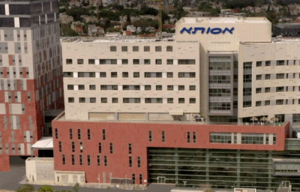Retinoblastoma
Disease description
Retinoblastoma is a malignant tumor of the retina that commonly affects children under the age of two. Approximately 25% of patients have bilateral hereditary involvement, 15% develop unilateral cancer, and 60% experience unilateral non-hereditary tumors.
The five-year survival rate for patients diagnosed at an early stage is 90%. However, in hereditary retinoblastoma, the recurrence rate doubles.
Symptoms indicating the need for diagnosis and treatment
- Leukocoria (white pupillary reflex) — a white reflection from the retina that appears as a bright spot in the eye
- Strabismus (crossed eyes)
- Visual impairment
- In late stages: orbital tumor, headaches, vomiting
Diagnostic and treatment methods
Diagnostic
- Ultrasound examination
- Computed tomography (CT) or magnetic resonance imaging (MRI)
- Optical coherence tomography (OCT)
- Bone scanning
- Bone marrow biopsy
- Lumbar puncture (collection of cerebrospinal fluid)
Treatment
In advanced unilateral cancer, leading European hospitals use enucleation and chemotherapy. For bilateral tumors, treatment includes photocoagulation, intra-arterial chemotherapy, and cryotherapy.
Innovations in global clinics
World-class medical centers apply molecular genetic testing, conducted in two stages. This analysis identifies the genetic cause of retinoblastoma (detecting damaged DNA) and enables the selection of targeted, etiotropic treatment.
Top clinics
-
 Max Grundig Clinic
Max Grundig Clinic -
 University Hospital Freiburg
University Hospital Freiburg -
 Acibadem Altunizade Clinic
Acibadem Altunizade Clinic -
 Medical Park Antalya Clinic
Medical Park Antalya Clinic -
 Dubai, UAE NMC Healthcare
Dubai, UAE NMC Healthcare -
 Milan, Italy San Donato Hospital in Milan, Italy
Milan, Italy San Donato Hospital in Milan, Italy -
 Milan, Italy San Raffaele University Hospital
Milan, Italy San Raffaele University Hospital -
 American Hospital Dubai
American Hospital Dubai -
 Burjeel Hospital Abu Dhabi
Burjeel Hospital Abu Dhabi -
 Debling Private Clinic
Debling Private Clinic -
 Confraternity Private Clinic.
Confraternity Private Clinic. -
 Rudolfinerhaus Private Clinic.
Rudolfinerhaus Private Clinic. -
 University Hospital Heidelberg
University Hospital Heidelberg -
 Vienna, Austria Wiener Privatklinik (WPK)
Vienna, Austria Wiener Privatklinik (WPK) -
 Oberhausen Clinic of the Niederrein Complex
Oberhausen Clinic of the Niederrein Complex -
 Munich, Germany University Hospital Munich (Ludwig-Maximilians-Universität)
Munich, Germany University Hospital Munich (Ludwig-Maximilians-Universität) -
 Asklepios Nord Heidberg
Asklepios Nord Heidberg -
 Charité Clinic
Charité Clinic -
 Lindbergh Clinic
Lindbergh Clinic -
 Clinique Montchoisy
Clinique Montchoisy -
 Clinique Genolier
Clinique Genolier -
 Barcelona, Spain QuironSalud Barcelona Hospital
Barcelona, Spain QuironSalud Barcelona Hospital -
 Barcelona, Spain Medical Center "Teknon"
Barcelona, Spain Medical Center "Teknon" -
 Barcelona, Spain Sant Joan de Deu Children's Hospital
Barcelona, Spain Sant Joan de Deu Children's Hospital -
 Barcelona, Spain University Hospital Barnaclinic+
Barcelona, Spain University Hospital Barnaclinic+ -
 Madrid, Spain University Clinic HM Madrid
Madrid, Spain University Clinic HM Madrid -
 Madrid, Spain University Hospital HM Monteprincipe
Madrid, Spain University Hospital HM Monteprincipe -
 Zurich, Switzerland Hirslanden Clinic
Zurich, Switzerland Hirslanden Clinic -
 Madrid, Spain Quiron Salud University Hospital
Madrid, Spain Quiron Salud University Hospital -
 Geneva, Switzerland Clinique des Grangettes
Geneva, Switzerland Clinique des Grangettes -
 Duesseldorf, Germany Oncological Center Dusseldorf
Duesseldorf, Germany Oncological Center Dusseldorf -
 Petah Tikva, Israel Schneider Children's Medical Center
Petah Tikva, Israel Schneider Children's Medical Center -
 Seoul, South Korea Samsung Medical Center
Seoul, South Korea Samsung Medical Center -
 г. Женева, Швейцария Клиника «Женераль-Болье»
г. Женева, Швейцария Клиника «Женераль-Болье» -
 г. Женева, Швейцария Hirslanden Clinique La Colline
г. Женева, Швейцария Hirslanden Clinique La Colline -
 г. Сеул, Южная Корея Медицинский центр «Асан»
г. Сеул, Южная Корея Медицинский центр «Асан» -
 г. Рамат-Ган, Израиль Клиника Шиба
г. Рамат-Ган, Израиль Клиника Шиба -
 г. Тель Авив, Израиль Медицинский центр “Ассута”
г. Тель Авив, Израиль Медицинский центр “Ассута” -
 г. Петах-Тиква, Израиль Медицинский центр имени Ицхака Рабина
г. Петах-Тиква, Израиль Медицинский центр имени Ицхака Рабина -
 г. Иерусалим, Израиль Медицинский центр “Хадасса”
г. Иерусалим, Израиль Медицинский центр “Хадасса”








































